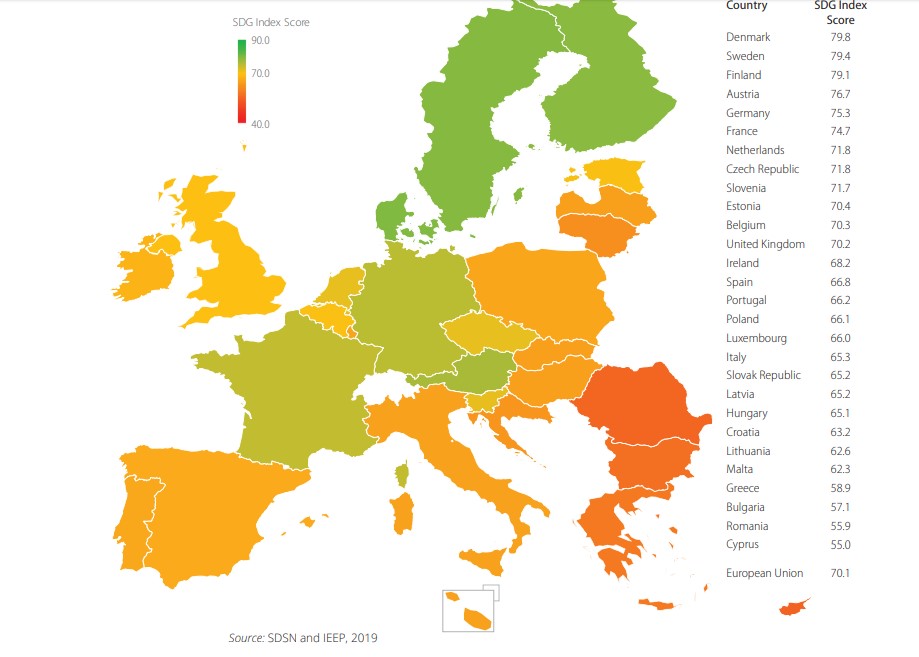The Sustainable Development Solutions Network (SDSN) and the Institute for European Environmental Policy (IEEP) publish today the first independent quantitative report on the progress of the European Union and its member states towards Sustainable Development Goals (SDGs), agreed by all UN member states in 2015. The Netherlands ranks on place 7 in the ranking of European countries.
As the new European Commission prepares the European Green Deal, the 2019 Europe Sustainable Development Report comes at a crucial time, shedding light on the key economic, social and environmental sustainability challenges faced by the member states and the European Union as a whole in their progress towards SDGs.
The report finds that:
- While European countries lead globally on the SDGs, none are on track to achieve the Goals by 2030.
- Countries closest to achieving the SDGs include Denmark, Sweden and Finland, whereas Bulgaria, Romania and Cyprus rank last among 28 countries assessed.
- The EU and its member states face the greatest challenges on goals related to climate, biodiversity, and circular economy, as well as achieving the convergence in living standards, both within each country as well as across countries and regions.
The EU generates large, negative spillovers that impede other countries’ ability to achieve the SDGs. The largest negative impacts are caused by unsustainable demand for agricultural, forest, and fishery products.
The report outlines six transformations that together can achieve all 17 SDGs and applies them to the European Union. It offers practical recommendations for how the EU and its member states can achieve the SDGs with a focus on three broad areas: internal priorities, diplomacy and development cooperation, and tackling negative international spillovers.
The good news is that the necessary instruments already exist to achieve the SDGs throughout the EU. The new Commission should therefore focus on aligning existing instruments and mechanisms (including budget, investment strategies, regulatory governance, monitoring frameworks) with the SDGs.
Key recommendations include:
- The European Green Deal can be the cornerstone for implementing the SDGs in the EU. It must include an EU-wide strategy to (i) fully decarbonise the energy system by 2050; (ii) strengthen the circular economy and achieve greater efficiencies in resource use and far lower waste; and (iii) promote sustainable land-use and food
systems by 2050. - The EU needs to increase public and private investments in sustainable infrastructure, including power and transport. This in turn will require greater financial resources for the EU.
- Europe needs to increase investments in education, job skills, and innovation, with a focus on STEM education at all levels and R&D for sustainable technologies.
- The EU needs to put SDGs at the centre of its diplomacy and development cooperation.
- The EU needs to strengthen policy coherence and address negative international spillovers that undermine other countries’ ability to achieve the SDGs.
Céline Charveriat, IEEP Executive Director: “The report shows Europe is not on track to achieve the Sustainable Development Goals. It is a wake-up call for the continent’s policymakers. The EU urgently needs a science-based Green Deal that addresses climate change, pollution, biodiversity and overconsumption. By creating a new, inclusive lowcarbon circular industry and agriculture, Europe can show the world that it is possible to preserve economic prosperity, while at the same time reducing inequalities and protecting the natural resources that we all depend on for our health and nutrition”
Guido Schmidt-Traub, SDSN Executive Director: “With the SDGs, the world has adopted Europe’s agenda of a social market economy. It is therefore critical that the EU lead internally and internationally on implementing the SDGs. The new Commission has announced bold action on the SDGs. Our report outlines how this ambition can be turned into reality using existing tools and better coordination of member states’ policies across the economic, social, and environmental dimensions of sustainable development. The European Green Deal, a European Semester aligned with the SDGs, and bold diplomacy with effective development cooperation will be the lynchpins of such a strategy.”



